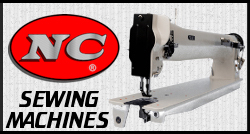-
Tobin Tirrell
0Hello all! I was hoping someone could point me in the right direction with a problem . . .
On our Consew 205-RB, we are having trouble making welting.
It will stitch straight / normal seams perfectly (even with the welting foot installed). You can back stitch with no problems at all.
However, with the exact same setup, we can not back stitch when making welting. About 80% of the time there is a slight "click" noise on back stitch, the bobbin side of the thread balls up, and the thread either breaks or frays severely.
The only difference we can see, is the thickness of the material and the welting cord. But we have made thousands of feet of welting on this same machine, with the same setup. We have not changed anything on the machine.
Does anyone know where to start? Thank you in advance! -
 Al Decker
22Whenever my machines decide to be fussy. I'll pull the thread & the bobbin, blow it all out. inspect the hook for nicks or burrs, install a new needle, lube it, then re-thread & install a newly wound bobbin.Then do a few test runs on some scrap. Check the tension & set the stitch length.
Al Decker
22Whenever my machines decide to be fussy. I'll pull the thread & the bobbin, blow it all out. inspect the hook for nicks or burrs, install a new needle, lube it, then re-thread & install a newly wound bobbin.Then do a few test runs on some scrap. Check the tension & set the stitch length.
Usually that's all it takes to smarten them up. -
 Gareth Judd
12the only thing i can suggest is try a different size piping/welt foot, i use a foot from 4-8mm depending on the job/piping thickness.
Gareth Judd
12the only thing i can suggest is try a different size piping/welt foot, i use a foot from 4-8mm depending on the job/piping thickness.
To me it sound like the piping/welt foot is to small or the machine is not walking high enough? -
 David Wismer
0I have had similar issues and have adjusted bobbin & hook assembly, move approx 1/32-3/64 to the right, what was happening was the pressure from welt[or offset thickness of materials being sewn] have been bending/pushing needle causing tip of hook to catch. Now of course. I am having a drop-stitch issue on other thicknesses such as heavy plastic extrusions, but not as critically, and have not finished my fine-tune as this adjustment just took place this week. But I did alleviate the issue at hand and it has allowed me to sew the "important" seams without issue. For every action, an equal to or greater reaction.
David Wismer
0I have had similar issues and have adjusted bobbin & hook assembly, move approx 1/32-3/64 to the right, what was happening was the pressure from welt[or offset thickness of materials being sewn] have been bending/pushing needle causing tip of hook to catch. Now of course. I am having a drop-stitch issue on other thicknesses such as heavy plastic extrusions, but not as critically, and have not finished my fine-tune as this adjustment just took place this week. But I did alleviate the issue at hand and it has allowed me to sew the "important" seams without issue. For every action, an equal to or greater reaction.
I could actually hand walk the needle foot downward and watch the needle bend to right and just catch hook tip.
Be very careful not to mess your timing up up when doing so.
I also believe the cheaper grade metal used in the needles has attributed to the needle bend. Needle thickness can also vary the amount of bend but I personally cannot use the thickest available on a lot of the stitchwork I do.
Dave -
Tobin Tirrell
0Thanks to everyone for the feedback! Gonna try some of the ideas here and will update. Really appreciate it!!
Welcome to The Hog Ring!
This forum is only for auto upholstery pros, apprentices and students. Join today to start chatting.
More Discussions








- Terms of Service
- Useful Hints and Tips
- Sign In
- Created with PlushForums
- © 2025 The Hog Ring


